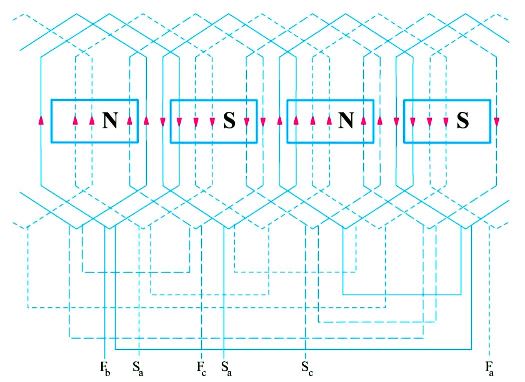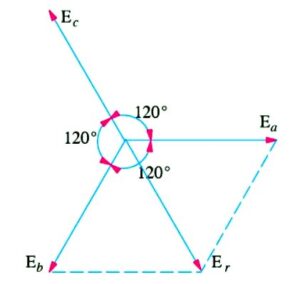Explain Generation of Polyphase Voltage
In this article, we will Explain Generation of Polyphase Voltage.
A single-phase alternator was diagrammatically depicted in Figure (A) and it was shown to have one armature winding only. But if the number of armature windings is increased, then it becomes polyphase alternator and it produces as many independent voltage waves as the number of windings or phases. These windings are displaced from one another by equal angles, the values of these angles being determined by the number of phases or windings. In fact, the word ‘polyphase’ means poly (i.e. many or numerous) and phases (i.e. winding or circuit).
In a two-phase alternator, the armature windings are displaced 90 electrical degrees apart. A 3-phase alternator, as the name shows, has three independent armature windings which are 120 electrical degrees apart. Hence, the voltages induced in the three windings are 120° apart in time phase.
With the exception of two-phase windings, it can be stated that, in general, the electrical displacement between different phases is 360/n where n is the number of phases or windings.
Three-phase systems are the most common, although, for certain special jobs, greater number of phases is also used. For example, almost all mercury-arc rectifiers for power purposes are either six-phase or twelve-phase and most of the rotary converters in use are six-phase. All modern generators are practically three-phase. For transmitting large amounts of power, three-phase is invariably used. The reasons for the immense popularity of three-phase apparatus are that (i) it is more efficient (ii) it uses less material for a given capacity and (iii) it costs less than single-phase apparatus etc.

In Figure (A) is shown a two-pole, stationary-armature, rotating-field type three-phase alternator. It has three armature coils aa′,bb′andcc′ displaced 120° apart from one another. With the position and clockwise rotation of the poles as indicated in Figure (A), it is found that the e.m.f. induced in conductor ‘a’ for coil aa′ is maximum and its direction is away from the reader.
The e.m.f. in conductor ‘b’ of coil bb′ would be maximum and away from the reader when the N-pole has turned through 120° i.e. when N-S axis lies along bb′. It is clear that the induced e.m.f. in conductor ‘b’ reaches its maximum value 120° later than the maximum value in conductor ‘a’. In the like manner, the maximum e.m.f. induced (in the direction away from the reader) in conductor ‘c’ would occur 120° later than that in ‘b’ or 240° later than that in ‘a’.
AdBlock-2

Thus the three coils have three e.m.fs. induced in them which are similar in all respects except that they are 120° out of time phase with one another as pictured in Figure (C). Each voltage wave is assumed to be sinusoidal and having maximum value of Em.
In practice, the space on the armature is completely covered and there are many slots per phase per pole.

Figure (B) illustrates the relative positions of the windings of a 3-phase, 4-pole alternator and Figure (D) shows the developed diagram of its armature windings. Assuming full-pitched winding and the direction of rotation as shown, phase ‘a’ occupies the position under the centres of N and S-poles. It starts at Sa and ends or finishes at Fa.

The second phase ‘b’ start at Sb which is 120 electrical degrees apart from the start of phase ‘a’, progresses round the armature clockwise (as does ‘a’) and finishes at Fb. Similarly, phase ‘c’ starts at Sc, which is 120 electrical degrees away from Sb, progresses round the armature and finishes at Fc. As the three circuits are exactly similar but are 120 electrical degrees apart, the e.m.f. waves generated in them (when the field rotates) are displaced from each other by 120°.
Assuming these waves to be sinusoidal and counting the time from the instant when the e.m.f. in phase ‘a’ is zero, the instantaneous values of the three e.m.fs. will be given by curves of Figure (C).
Their equations are :
ea = Em sinωt ……………………………………………. (i)
eb = Em sin(ωt −120° ) ……………………………..… (ii)
ec = Em sin(ωt −240° ) ……………………………..… (iii)
As explained in Article Representation of Alternating Quantities, alternating voltages may be represented by revolving vectors which indicate their maximum values (or r.m.s. values if desired). The actual values of these voltages vary from peak positive to zero and to peak negative values in one revolution of the vectors. In Figure (E) are shown the three vectors representing the r.m.s. voltages of the three phases Ea, Eb and Ec (in the present case Ea = Eb = Ec = E, say).

It can be shown that the sum of the three phase e.m.fs. is zero in the following three ways :
(i) The sum of the above three equations (i), (ii) and (iii) is zero as shown in figure (D)

Resultant instantaneous e.m.f.
= ea + eb + ec
= Em sinωt + Em sin(ωt −120° ) + Em sin(ωt −240° )
= Em [sinωt + 2sin(ωt −180° )cos 60°]
= Em [sinωt + 2sinωt cos 60°]
= 0
(ii) The sum of ordinates of three e.m.f. curves of figure (C) is zero. For example, taking ordinates AB and AC as positive and AD as negative, it can be shown by actual measurement that
AB + AC + (– AD) = 0
(iii) If we add the three vectors of Figure (E) either vectorially or by calculation, the result is zero.

Vector Addition
As shown in Figure (F), the resultant of Ea and Eb is Er and its magnitude is 2E cos 60° = E
where Ea = Eb = Ec = E.
This resultant Er is equal and opposite to Ec. Hence, their resultant is zero.
By Calculation
Let us take Ea as reference voltage and assuming clockwise phase sequence
Ea = E∠0o = E + j0
Eb = E∠-240o = E∠120o = E(-0.05 + j0.866)
Ec = E∠-240o = E∠120o = E(-0.05 + j0.866)
∴ Ea + Eb + Ec = (E + j0) + E(-0.05 + j0.866) + E(-0.05 + j0.866) = 0
Read article – Representation of Alternating Quantities
Visit NCERTplanet.com for NCERT solutions and Textbook downloads




